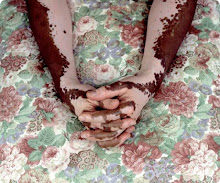src="http://pagead2.googlesyndication.com/pagead/show_ads.js">
Vitiligo is catagorised in the following types:
1. Localized Vitiligo: Focal pattern vitiligo, Segmental pattern vitiligo
2.Generalized Vitiligo: Acrofacial vitiligo, Vulgaris Vitiligo, Universal vitiligo
Hereunder some detail of the above vitiligo types.
1. Localized Vitiligo
Focal Vitilgo:
One or more macules in one area but not clearly in a segmental distribution.
In general terms Focal Vitiligo is localized to a single area. If the patient has a single patch on hand, face or leg with no other occurrences of disease on other body parts.
Focal vitiligo if not active is generally more suited for localized treatments. The first option would be a topical medicine and if it does not work or is unacceptable due to other reasons, surgery and tattooing may be considered.
Segmental Pattern Vitiligo:
Where one or more macules are in a quasi-dermatomal pattern. In common mans language Here the patches are unilateral and asymmetric in distribution.
One or more patches are distributed within the same segment (anatomical distribution of the body) of the body. Segmental vitiligo limited to lips and finger tips is often called Lip-Tip Vitiligo. This is perhaps most difficult to treat. Lip-tip Vitiligo: These are restricted to the lips and distal part of fingers and toes .
2. Generalized Vitiligo
Acrofacial Vitiligo:
Affecting distal extremities and face. Some patches on face and some on other body parts, but not on all over the body.
In common terms, Acrofacial vitiligo is the term used for a very common distribution of this disease in which the disease is limited to parts away from the center of the body. This usually include face, head, hands and feet. It is usually associate with a lot emotional distress because the disease effects the exposed parts of the body, which is socialy very emparcing.
Vulgaris Vitiligo:
In vitiligo valgaris small patches of de-pigmentation are spread in a shower pattern admixed with normal skin in segmental or acrofacial pattern.
This is the most common type with bilaterally symmetrical lesions, predominantly distributed over face, neck, torso, fingers, toes, palms, soles and facial orifices.
Due to wide spread of disease it is generally difficult to treat all the parts equally and the treatment may take years. Also surgery may not be an option for patients of vitiligo vulgaris.
Universal Vitiligo:
Universal Vitiligo or Vitiligo totalis is the complete or nearly complete loss of skin pigment. The pigment is usually lost from entire body surface except a few small islands of normally pigmented skin. Permanent medical bleaching of the normal skin is usually the only option.
I am grateful to the adminstration of the site anti-vitiligo for give me the usefull info about the type of Vitiligo. I hope this post would be very useful for both patients and researcher of vitiligo.

3 comments:
This is no doubt very precise info about the types of vitiligo. the author should write some words about the treatment of vitiligo.
Thank you and sorry for not responding to your comment, actually i just noticed it.
since i havent put the buzz out there yet about my site i just never bother to look.
do you have pics of yourself and or do you know people that i could contact to put pics of themselves on maipecanswirl?
they dont have to show their faces if they dont want. just want to hear their stories if they are willling to share.
what do you think about that? how bout you to start? :-)
Vitiligo affects the skin, eyes, and mucous membranes by destroying cells that produce the body's pigment. The most obvious results of this condition are white splotches in the areas where the skin isn't producing enough pigment. This is not a serious condition, but research physicians are still investigating methods for correct diagnosis, treatments, co-existent diseases…..
www.botanical-source.com
Post a Comment